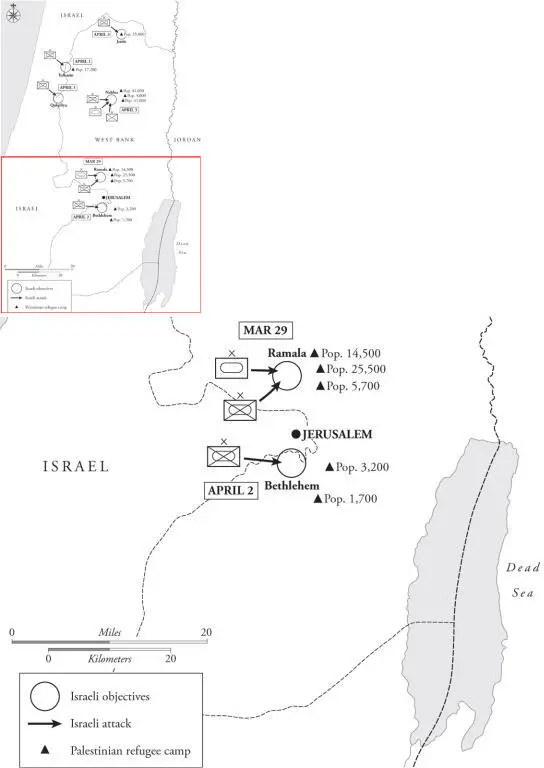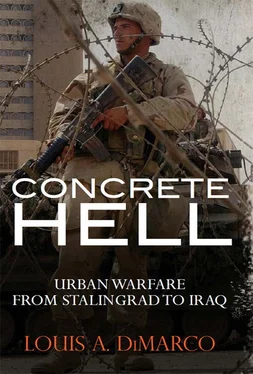The IDF operations in the West Bank were aimed at disrupting three terrorist organizations, and by implication they also had to deal with a fourth organization that was armed and a potential adversary. The latter was the PA police forces. These forces were responsible for law and order in the West Bank, and were loyal to the PA led by Yasser Arafat. Thus, although they were not actively attacking Israel, they were expected to oppose the IDF incursion into the West Bank. There were three primary militant groups in the West Bank. The Al Aqsa Martyrs’ Brigade specialized in suicide bombings as well as gun attacks. In 2002 they were covertly sponsored by the Fatah party, a relationship that was only admitted to after Operation Defensive Shield. The Palestinian Islamic Jihad was a small but deadly group that originated in Egypt and after several migrations was based out of Damascus, Syria. They had a close association with the Hezbollah terrorist group in Lebanon and through them with Iran. The last important active terrorist group opposing the Israelis in 2002 was Hamas. Hamas was the political rival of Fatah and had its strongest support in Gaza. However, like the other groups, it had a strong presence in the West Bank. Hamas was responsible for the very deadly Park Hotel attack just prior to the Israeli offensive. All three groups used the urban centers of the West Bank as bases for operations in and against Israel. They also used those bases to manufacture weapons, as recruiting and training stations, and to plan and conduct propaganda campaigns.
Map 9.1 Operation Defensive Shield , March–April 2002


The IDF Responds to the Terrorist Attacks
Operation Defensive Shield began on March 29 as Israeli military forces launched into the West Bank to seize control of the city of Ramallah. The major objective in Ramallah was the headquarters of the PA and Fatah, and its leader Yasser Arafat. The IDF attacked Ramallah with a combined infantry and armor force supported by attack helicopters. IDF forces quickly penetrated into Arafat’s Tegart Fort compound and surrounded him in the offices of one building. By the end of the day the IDF had secured the city with no losses to the attacking forces. A curfew was imposed and the IDF then began to systematically seek and arrest known and suspected terrorists. Over 700 individual arrests were made. Thirty defending Palestinian militants and PA police were killed. Arafat remained in his headquarters, with all communications cut off, under house arrest, until May.
Two days after the seizure of Ramallah, April 1, the IDF seized the two border towns of Tulkarm and Qalqiliya. The IDF operations were not seriously resisted in either town. In Tulkarm nine militants were killed and the Tegart Fort used as the headquarters for the PA in the city was destroyed by an air strike. The next day IDF forces moved across the border into Bethlehem. That operation, thought to be relatively simple, turned into an international incident as the IDF surrounded and laid siege to 32 militants and over 200 hostages in the Christian Church of Saint Mary, thought to be the birthplace of Jesus Christ.
No substantial fighting units were thought to be in Bethlehem and the city itself borders on Israel proper, so staging and moving into the city were not considered major problems. For this reason, the mission was assigned to the IDF Reserve Jerusalemite Brigade, an IDF reserve unit. There was a high-value person list for Bethlehem whose arrests were a priority task of the operation. The IDF knew, from previous experience, that one course of action the militants could pursue, if given the opportunity, was flee to the Church of Saint Mary. This had happened on at least one previous occasion. For this reason the Jerusalemite Brigade was supported in its mission by the elite Air Force Shaldag commando unit (also known as Unit 5101). One of the commando’s missions was to secure the church to prevent its use as a sanctuary.
The operation was executed against sporadic and ineffective resistance and the town quickly came under IDF control. However, the Shaldag unit was delivered by Israeli Air Force helicopters to its positions a half hour late. That was sufficient time for armed militants to escape capture and find sanctuary in the Catholic church, and to take hostages. The church was quickly surrounded by IDF infantry and tanks and a 39-day siege began. Over the course of the next five weeks, the siege and IDF tactics and actions were subjected to the scrutiny of the international media and the subject of much diplomacy. During the siege, eight militants were shot and killed by IDF snipers stationed around the building. Two Israeli border police were wounded in one of the several small firelights that occurred. In the end, however, the siege was ended diplomatically with all the hostages released unharmed, and 39 militants going into exile in Sicily and Europe.
The major focus of Operation Defensive Shield was the two urban areas attacked on April 2 and 3, Nablus and Jenin. Nablus was considered the most difficult mission for several reasons: it was located deepest in the West Bank, it was the largest in total population, and it had the most refugee camps and the largest refugee population at over 70,000. Because of this the mission of seizing the city was assigned to the active army West Bank Division under Brigadier General Yitzhak Gershon. For the mission the division had two veteran Israeli brigades: the Northern Command’s Golani Infantry Brigade and the Paratrooper Brigade. The IDF activated a reserve armor brigade and assigned it to the division to provide support for the infantry.
Operations in Nablus began on April 3 and took about five days to complete. By April 8 the last militant fighters holding out in the old city casbah decided to surrender. The Israeli plan to capture the city was relatively simple. The Paratrooper brigade was responsible for clearing the Balata Refugee Camp, the largest in the West Bank with over 20,000 residents packed into a maze of buildings in .25km 2. The brigade would then move west and enter the casbah, the old city quarter. The Golani Brigade moved through the city and attacked the old city quarter directly. Both brigades were extremely successful in accomplishing their mission of killing or capturing militants while at the same time minimizing civilian casualties, collateral damage, and most importantly, minimizing Israeli casualties, but they took dramatically different tactical approaches to achieving their aim.
The Golani Brigade, as mechanized infantry, took an equipment-centric approach to attacking Nablus. The general tactic was to work as an engineer, infantry, armor team. Tanks overwatched the tactics and suppressed enemy fire or potential enemy positions with machine-gun and tank fire. If the building being assaulted was occupied, the tank softened it up with fire from its main gun. The infantry assault was led by an engineer D9 bulldozer. The armored bulldozer was impervious to all Palestinian fire and it cleared the approach to the building of booby-traps, mines, and in many cases widened the alley or street so that it was large enough for the infantry carriers and tanks to follow. Once at the building, the D9 used its blade to collapse a wall and then withdrew. The dozer was followed by an Achzarit heavy armored personnel carrier. The carrier brought the infantry right to the building where they dismounted and attacked into the building through the breach created by the dozer. This method was a slow, firepower-intensive method that did a lot of damage to buildings but kept the advancing IDF force under armor protection most of the time. Special forces snipers also worked with the advancing mechanized force, picking off Palestinian fighters at long range as they attempted to flee, or maneuvered against the flanks of the advancing vehicles and infantry.
Читать дальше














